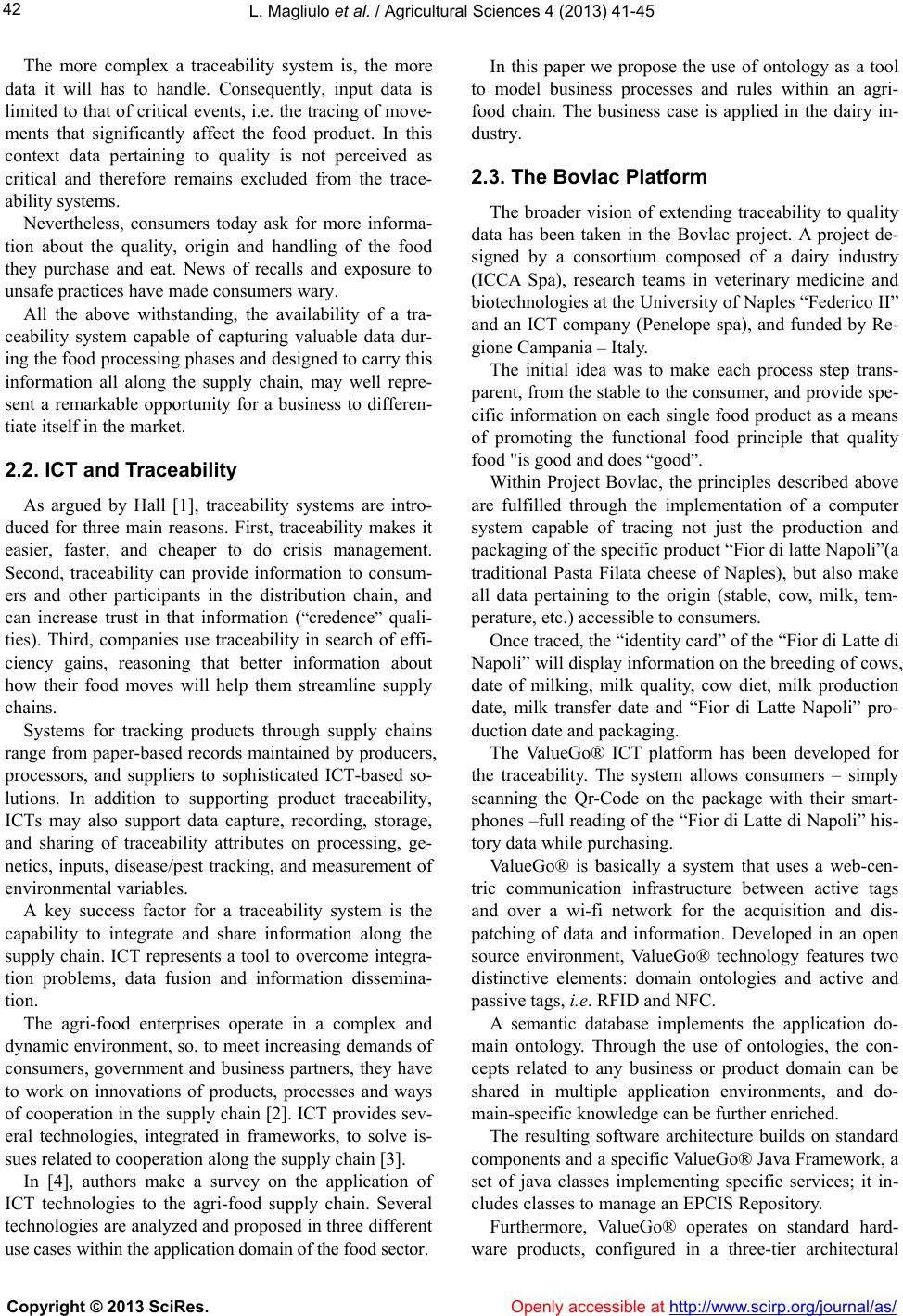
L. Magliulo et al. / Agricultural Sciences 4 (2013) 41-45
42
The more complex a traceability system is, the more
data it will has to handle. Consequently, input data is
limited to that of critical events, i.e. the tracing of move-
ments that significantly affect the food product. In this
context data pertaining to quality is not perceived as
critical and therefore remains excluded from the trace-
ability systems.
Nevertheless, consumers today ask for more informa-
tion about the quality, origin and handling of the food
they purchase and eat. News of recalls and exposure to
unsafe practices have made consumers wary.
All the above withstanding, the availability of a tra-
ceability system capable of capturing valuable data dur-
ing the food processing pha ses and designed to carry this
information all along the supply chain, may well repre-
sent a remarkable opportunity for a business to differen-
tiate itself in the market.
2.2. ICT and Traceability
As argued by Hall [1], traceability systems are intro-
duced for three main reasons. First, traceability makes it
easier, faster, and cheaper to do crisis management.
Second, traceability can provide information to consum-
ers and other participants in the distribution chain, and
can increase trust in that information (“credence” quali-
ties). Third, companies use traceability in search of effi-
ciency gains, reasoning that better information about
how their food moves will help them streamline supply
chains.
Systems for tracking products through supply chains
range from paper-based records maintained by producers,
processors, and suppliers to sophisticated ICT-based so-
lutions. In addition to supporting product traceability,
ICTs may also support data capture, recording, storage,
and sharing of traceability attributes on processing, ge-
netics, inputs, disease/pest tracking, and measurement of
environmental variables.
A key success factor for a traceability system is the
capability to integrate and share information along the
supply chain. ICT represents a tool to overcome integra-
tion problems, data fusion and information dissemina-
tion.
The agri-food enterprises operate in a complex and
dynamic environment, so, to meet increasing demands of
consumers, government and business partners, they have
to work on innovations of products, processes and ways
of cooperation in the supply chain [2]. ICT provides sev-
eral technologies, integrated in frameworks, to solve is-
sues related to cooperation along the supply chain [3].
In [4], authors make a survey on the application of
ICT technologies to the agri-food supply chain. Several
technologies are analyzed and proposed in three different
use cases within the application domain of the food sector.
In this paper we propose the use of ontology as a tool
to model business processes and rules within an agri-
food chain. The business case is applied in the dairy in-
dustry.
2.3. The Bovlac Platform
The broader vision of extending traceability to quality
data has been taken in the Bovlac project. A project de-
signed by a consortium composed of a dairy industry
(ICCA Spa), research teams in veterinary medicine and
biotechnologies at the University of Naples “Federico II”
and an ICT company (Penelope spa), and funded by Re-
gione Campania – Italy.
The initial idea was to make each process step trans-
parent, from the stable to the consumer, and provide spe-
cific information on each sing le food product as a means
of promoting the functional food principle that quality
food "is good and does “good”.
Within Project Bovlac, the principles described above
are fulfilled through the implementation of a computer
system capable of tracing not just the production and
packaging of the specific product “Fior di latte Napoli”(a
traditional Pasta Filata cheese of Naples), but also make
all data pertaining to the origin (stable, cow, milk, tem-
perature, etc.) accessible to consumers.
Once traced, the “identity card” of the “Fior di Latte di
Napoli” will display information on th e breeding of cows,
date of milking, milk quality, cow diet, milk production
date, milk transfer date and “Fior di Latte Napoli” pro-
duction date a n d p ackaging.
The ValueGo® ICT platform has been developed for
the traceability. The system allows consumers – simply
scanning the Qr-Code on the package with their smart-
phones –full reading of the “Fio r di Latte di Napoli” his-
tory data while purchasing .
ValueGo® is basically a system that uses a web-cen-
tric communication infrastructure between active tags
and over a wi-fi network for the acquisition and dis-
patching of data and information. Developed in an open
source environment, ValueGo® technology features two
distinctive elements: domain ontologies and active and
passive tags, i.e. RFID and NFC.
A semantic database implements the application do-
main ontology. Through the use of ontologies, the con-
cepts related to any business or product domain can be
shared in multiple application environments, and do-
main-specific knowledge can be further enriched.
The resulting software architecture builds on standard
components and a specific ValueGo® Java Framework, a
set of java classes implementing specific services; it in-
cludes classes to manage an EPCIS Repository.
Furthermore, ValueGo® operates on standard hard-
ware products, configured in a three-tier architectural
Copyright © 2013 SciRes. Openly accessible at http://www.scirp.org/journal/as/